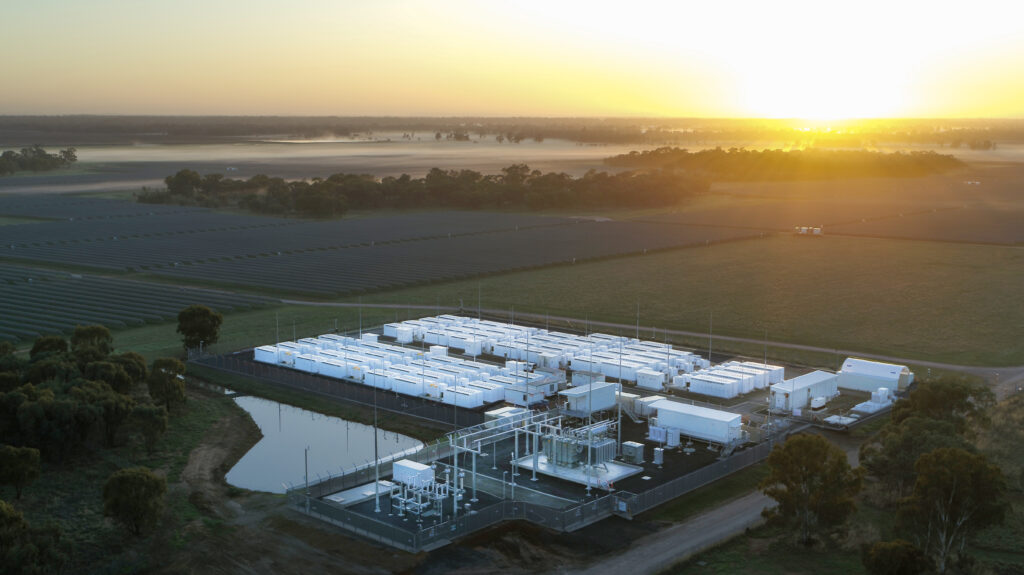The Riverina and Darlington Point Energy Storage System (Riverina battery system), built by Edifiy Energy and Federation Asset Management, comprises three independent but co-located units which are contracted to Shell Energy and EnergyAustralia for 10 years.
The project, built adjacent to the 275 MW Darlington Point Solar Farm in the state’s Riverina region, comprises the 60 MW/120 MWh Riverina 1, the 65 MW/130 MWh Riverina 2 and the 25 MW/50 MWh Darlington Point battery energy storage systems. The battery system’s output is sufficient to supply 240,000 homes with two hours of electricity at peak times.
Edify Chief Executive John Cole said the grid-forming battery system “elevates the playing field” with the firming technology helping to iron out the variable output of wind and solar.
“The potential for battery storage technology is immense,” he said. “It is a key part of the clean energy transition and goes hand in glove with harnessing and firming Australia’s abundant renewable resources.”
The Riverina battery system utilises Tesla Megapacks fitted with grid-forming inverters, operating in a ‘virtual synchronous generator’ mode. This allows the storage system to function in a manner similar to a traditional generator, providing crucial system strength services to help facilitate the connection of future clean energy power plants in the region.
“Advanced power electronics technology is key to addressing our energy challenges,” Cole said.
Edify designed and developed the battery but in June sold a 90% stake in the project to Federation Asset Management.
Stephen Panizza, co-founder and head of renewable energy at the Sydney-based private equity firm said the need for large-scale energy storage is becoming increasingly important as the nation’s aging coal plants retire.
“Advanced grid-forming batteries like the Riverina BESS are critical to extracting the maximum capacity from our existing grid infrastructure, allowing timely integration of additional wind and solar generation into the NEM while our grid infrastructure is upgraded,” he said.
The Riverina battery system is the largest battery energy storage system yet connected to the National Electricity Market in NSW, having overtaken the 50 MW/75 MWh Wallgrove Grid Battery in western Sydney.
Both batteries are however set to be relegated with a plethora of mega-scale batteries planned for NSW.
Origin Energy has commenced construction of the first stage of a planned 700 MW/2,800 MWh battery at its coal-fired power plant site at Eraring in the NSW Hunter region. Stage one of the Eraring battery involves the construction of a 460 MW battery storage system with a dispatch duration of two hours. French energy giant Neoen has announced plans to build a 500 MW/1,000 MWh big battery at the site of the former Wallerawang coal power station site in the Central Tablelands region. Shell Energy is also seeking to develop a 500 MW/1,000 MWh battery at that site while electricity gen-tailer EnergyAustralia is planning to build a 500 MW/2,000 MWh battery energy storage system adjacent to its Mount Piper coal-fired power station in the state’s central west.
These batteries will however all be overshadowed by the proposed Waratah Super Battery Project that is being built by BlackRock battery offshoot Akaysha Energy on the state’s Central Coast.
The 850 MW/1,680 MWh battery, being installed at the site of the decommissioned Munmorah coal-fired power station near Doyalson north of Sydney, will be the largest standby network battery in the Southern Hemisphere and one of the biggest in the world.
Construction of the WSB began in May and is targeted for completion before August 2025.
This content is protected by copyright and may not be reused. If you want to cooperate with us and would like to reuse some of our content, please contact: editors@pv-magazine.com.




1 comment
By submitting this form you agree to pv magazine using your data for the purposes of publishing your comment.
Your personal data will only be disclosed or otherwise transmitted to third parties for the purposes of spam filtering or if this is necessary for technical maintenance of the website. Any other transfer to third parties will not take place unless this is justified on the basis of applicable data protection regulations or if pv magazine is legally obliged to do so.
You may revoke this consent at any time with effect for the future, in which case your personal data will be deleted immediately. Otherwise, your data will be deleted if pv magazine has processed your request or the purpose of data storage is fulfilled.
Further information on data privacy can be found in our Data Protection Policy.